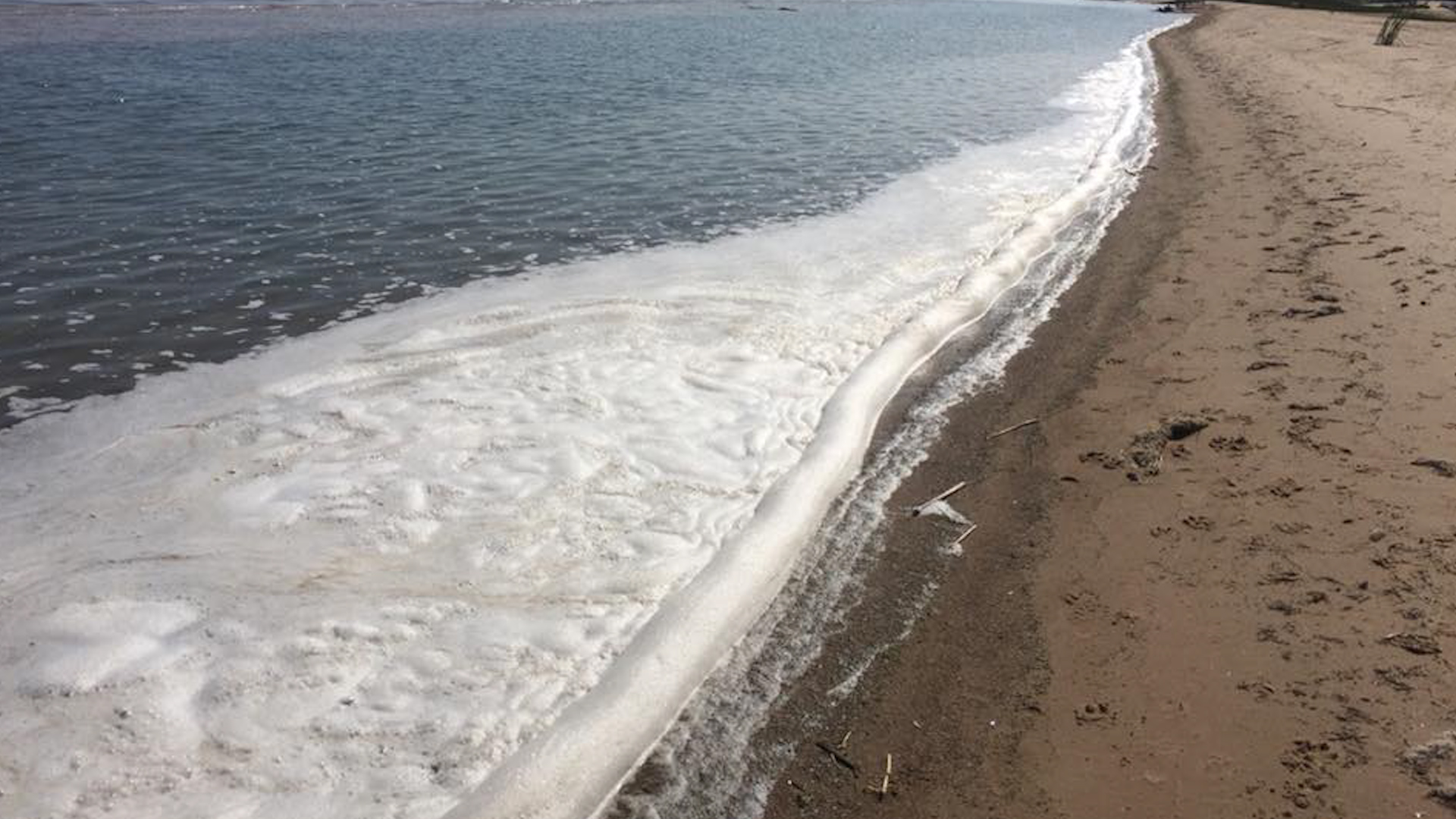
PFAS research is still in the early stages, which means issues with PFAS crop up all the time to surprise researchers like Michigan State University professor Cheryl Murphy.
PFAS, per- and polyfluoroalkyl substances, are known as Forever Chemicals because of their reluctance to break down in humans. They can be in the food chain, drinking water and are found in common items in everyday commercial use like water-repellent clothing, dental floss and non-stick cookware.
Murphy directs MSU’s Center for PFAS Research. Great Lakes Now contributor Gary Wilson recently talked with her about how scientists are approaching PFAS research.
Murphy, originally from Canada, explained the different approaches the U.S. and Canada are taking to deal with PFAS and why it is a threat to Michigan’s vast supply of groundwater, also referred to as the sixth Great Lake.
In January, MSU received a $1.9 million grant to look at toxicity in PFAS, and Murphy will lead the multi-institutional team of researchers conducting the study.
The interview was conducted on the phone and via email. It was recorded, transcribed and edited for clarity and length.
Great Lakes Now: PFAS seems omnipresent in the environment and our daily lives. It’s in the air, water, soil and countless commercial products we use. How do researchers approach a problem this complex, widespread and with an impact on public health?

Michigan State University Professor Cheryl Murphy, director of the Center for PFAS Research
Cheryl Murphy: That’s a really good question. The approach that seems to be emerging to address the PFAS issue, because it is widespread and affects almost every aspect of our lives, is to embrace an interdisciplinary approach. To get multi-disciplinary experts together to tackle the problem.
You see that happening with different agencies in the state of Michigan. When it first started looking at the PFAS issue, it created an overarching organization, the Michigan PFAS Action Response Team, or MPART. It unites the different agencies to tackle the problem.
MSU realized that PFAS is hitting all sorts of different aspects of our mission, so we formed a center that crosses several colleges across campus to tackle PFAS from different angles. Because PFAS is so complex, we need collaboration and people to lend their expertise to the issue. We can’t only rely on PFAS experts because there aren’t many of them.
GLN: What’s the state of PFAS research in Michigan. Is it advanced, in the early stages or somewhere in between?
CM: Michigan has been one of the leaders in determining where contamination is occurring in drinking water and groundwater. If you look at the progression of maps that show the extent of PFAS contamination throughout the U.S, in the early sampling stages, it looked like Michigan was completely contaminated. But more states are now onboard and are following Michigan’s lead in finding contamination. It’s likely in many places, but Michigan started looking for it aggressively early.
As a result, we’re getting a good sense of where it’s occurring and what’s happening.
With PFAS contaminants themselves, there are two that have been studied extensively for decades, PFAS and PFOA. We’re just now determining toxicity values and allowable levels in water, drinking water and food. However, there are estimates of between 5,000 and 10,000 of these chemicals and we only really know detailed information about two of them.
More information is being developed about some of the others, but we can’t dedicate the amount of effort to those that we’ve put into the two, we don’t have the resources or the time. We need to change the way we assess toxicity by embracing more systems-level approaches.
What’s the status? We know quite a bit about two, but it took a long time to get there and we don’t know a lot about the rest. The problem is that these chemicals don’t operate like typical contaminants we are familiar with. For example, PCBs or mercury. PCBs had 209 congeners (as opposed to over 5,000) and we thought that was a lot at that time.
We’ve thrown all the tools we have developed for chemicals like PCBs at PFAS. But PFAS operates differently, and we don’t have a complete picture of how these chemicals disrupt biology.
GLN: The executive director of Michigan’s PFAS Action Response Team testified before Congress last December and called for “additional studies of PFAS in the food supply to understand how PFAS enters and affects the food supply, and potential health risks from PFAS in food.” How can scientists best approach the study of PFAS and the food chain?
CM: The U.S is different from Canada in that Canada focused on the food web first. The U.S. has been focused on PFAS in drinking water. Drinking water contamination is serious and near contaminated sites, drinking water is probably the dominant source of contamination. But people not near a contaminated site will likely acquire PFAS through food or exposure from commercial products like a water-repellent jacket, dental floss or non-stick cooking utensils.
It’s a huge concern because we don’t have a grasp of how it moves through the food web. The Canadians have studied that quite a bit, and there are a few programs in the U.S. that are looking at it. We have to figure out what is the most dominant source of contamination. Is it through what people are eating or drinking? There are studies that suggest that you get very different contamination patterns through either food or drink.
GLN: In March, Michigan officials released a PFAS smelt fish consumption advisory for Lake Superior, which is generally thought to be the most pristine of the Great Lakes. Michigan’s action followed a similar advisory by Wisconsin. Were you surprised by the Lake Superior advisory?
CM: Things about PFAS surprise me all the time. Yes, it is surprising as it’s strange for them to show up in something like smelt. PFAS doesn’t show a typical pattern of bioaccumulation, so smelt, for other types of contaminants, would not be a concern.
Because Lake Superior is a colder, large lake with a large surface area, it means a lot of contaminants will precipitate to it. For Lake Superior to be considered pristine is interesting, because it will collect lots of contaminants like toxaphene.
GLN: Michigan is home to a vast reserve of groundwater that’s often referred to as the sixth Great Lake. It serves an estimated 45 percent of the people in Michigan. What’s the status of groundwater research related to PFAS?
CM: PFAS has chemical properties that make it highly mobile in water. It acts a bit like a cell membrane, and has a hydrophobic part and a hydrophilic part. It doesn’t take much PFAS to contaminate water. Right now, focus has been on documenting where PFAS is occurring. There are efforts underway to model transport, but these models still require extensive data. As models are developed, they identify data gaps that could be targeted by more sampling. We are still early in this iterative process.
GLN: Back to Canada, given your Canadian background, are there lessons to be learned from Canada or are U.S. and Canadian researchers in sync?
CM: There’s a lot to be learned from the Canadian perspective.
Collaboration between the two countries would be beneficial on these issues. Canada focused on food not through the food web, so they’re finding it in fish and wildlife and how that moves into communities that are reliant on fish and wildlife for their main source of food. Inuit communities were located that were highly contaminated with PFAS, and they’re getting it through their food items, and there is minimal industrial production in the Arctic. They’re getting it through global transport of contaminants.
As mentioned, the U.S. is focused on drinking water, so the combination of both approaches and building on them would help us all. There’s a lot to be learned from both countries.
Catch more news at Great Lakes Now:
Small portions: Michigan puts PFAS advisory on Lake Superior rainbow smelt
Featured image: PFAS foam on a beach near the decommissioned Wurtsmith Air Force Base in Iosco County, Mich. (Great Lakes Now Episode 1025)




